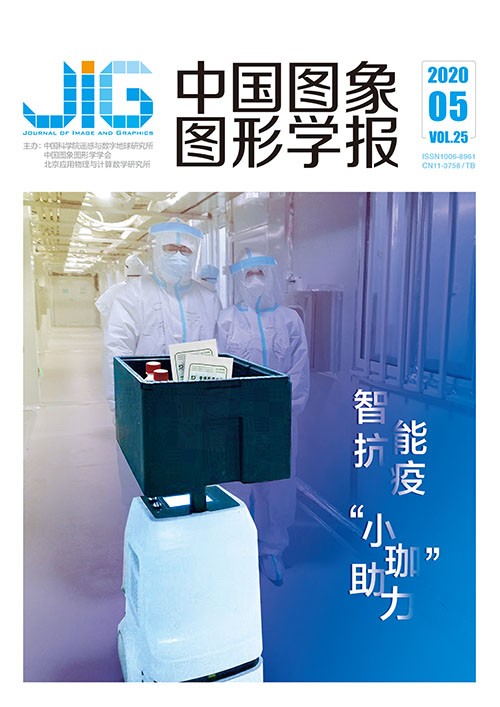
统筹图像变换与缝合线生成的无参数影像拼接
摘 要
目的 为解决小重叠度、大视角影像自然拼接问题,提出一种统筹图像变换和缝合线生成过程的影像拼接新方法。方法 主要包括两部分:1)将单应性映射引入到薄板样条变换(thin plate spline,TPS)并建立二次图像变换模型,在同一变换框架下进行全局单应性透视变换及基于径向基函数的局部映射调整,实现拼接影像透视特性良好保持与减少局部变形,且有效满足缝合线控制点无误差配准计算需要;2)根据控制点像素配准精度优于非控制点像素配准精度,对基准影像控制点集进行三角构网,并从中搜索初始缝合线,结合二次配准模型参数和动态规划匹配过程,获得控制点更密集且配准误差总体最小的最终缝合线,有效抑制图像融合时鬼影现象的产生,且计算实现上更简单。结果 对两组标准影像进行拼接测试,并与3种方法(双单应性变换(dual-homography warping,DHW)、平滑变化的仿射拼接(smoothly varying affine stitching,SVA)、尽可能投影(as-projective-as-possible, APAP)的移动直接线性变换拼接(image stitching with moving direct linenr transform(DLT))对比,本文方法拼接影像局部变形失真最小、匹配控制点配准精度最高:在railtracks影像训练集(trarning set, TR)、测试集(test set)上分别为0和2.27;在temple影像训练集TR、测试集TE上分别为0和1.46;不同场景多路采集视频影像拼接透视特性保持良好,视觉效果自然。结论 本文方法影像拼接时无先验知识要求、参数可线性求解,整体视觉效果流畅、重叠区域与非重叠区域过渡平滑,具有较好的应用价值。
关键词
Stitching of parametric-free images based on coordinated image transformation and seam-line generation
Gao Jiongli1, Wu Jun1, Liu Qichang1, Xu Gang2(1.School of Electronic Engineering and Automation, Guilin University of electronic technology. Guilin 541004, China;2.Ningbo Institute of Metenals Technology&Engineering, Chinese Acaderny of Sciences, Ningbo 315201, China) Abstract
Objective Image stitching technology aims to resample a group of interrelated (overlapping) images into a single image with a large angle of view and high resolution. This technology effectively overcomes the density limitation of a sensor array on the focal plane of common image acquisition equipment. Currently, numerous applications, such as realize virtual reality, security monitoring, and remote sensing detection, use the image stitching technology to obtain visual information of macro scenes and achievements have been made in the development of image stitching technology. However, due to the complexity of scene content, illumination conditions, and the changeability of camera pose, the acquisition of natural-looking visual effects of stitching image still depends mainly on post-processing interactively. Especially for applications with low measurement requirements and emphasis on visual experience, the parameter-free image stitching technology ignoring prior knowledge (scene 3D structure, camera parameters) is more valuable. To this end, this study presents a novel approach of stitching parametric-free images by comprehensively considering the process of image registration and fusion. Method The ghost phenomenon originates from an inaccurate image transformation model. Potential parameter estimation error has the greatest impact on the visual experience of stitching images. At present, the effective way to solve the problem is to find an optimal seam-line in overlapping regions of images to be stitched and take only one image pixel on each side of the seam-line for image fusion operation. Usually, the parameters of image transformation model are estimated using a set of control points located in overlapping regions of images. Thus, the accuracy of transformation at control points is better than that at non-control points. Accordingly, this study proposes to automatically generate an optimal seam-line from matched feature points for image stitching purpose. This technology mainly involves two aspects. The first one is the twice registration framework based on modified TPS (thin plate spline) transformation. It is established to meet the needs of error-free control point registration and automatic generation of reliable seam-line. In this step, the global homograph mapping and local mapping adjustment based on radial basis function are ingeniously incorporated into the uniform spatial transformation framework. Thus, it maintains perspective geometry and reduces local distortion in stitching image as much as possible. The second one is the reliable seam-line generated based on the fact that the registration accuracy of control point pixels is better than that of non-control point pixels in the process of image transformation. In this step, the initial seam-line is primarily searched out from triangulated control points in the reference image. Then, it is refined by adding more control points through dynamic programming matching process and remapping non-control point pixels with the transformation parameters estimated in advance. With the small registration error of pixels on seam-line, troublesome ghost phenomenon in stitching images can be effectively suppressed with computationally simpler image fusion operation. Result The experiments on two sets of standard images from the Internet are performed and compared with state-of-the-art methods in extant literature. The transformation accuracy of training set and test set of matching control points is found to be the highest in this study, whereas the local distortion of mosaic images is the smallest. Moreover, the stitching test is also performed on multiple videos with two different scenes. Its visual mosaic effect is quite natural. Conclusion The proposed method has a natural transition between images’ overlapping and non-overlapping areas and achieves better visual effect in stitching images. Furthermore, it requires no prior knowledge on images, and its parameters can be solved linearly. Thus, it exhibits huge potential for application.
Keywords
image stitching image transformation image fusion seam-line generation panoramic image thin plate spline(TPS)
|



 中国图象图形学报 │ 京ICP备05080539号-4 │ 本系统由
中国图象图形学报 │ 京ICP备05080539号-4 │ 本系统由